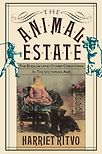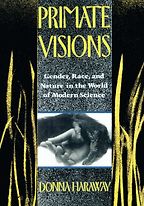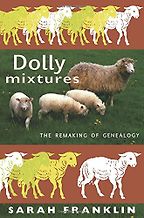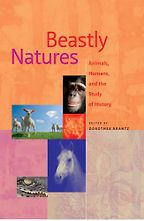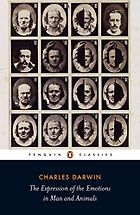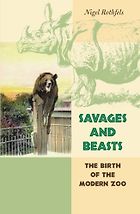The role of animals in human history is our subject, a field you’ve forged. Before we delve into the books, can you tell us how this species of history came to be?
Often the focus of historians reflects, even when exploring things from the past, concerns in the present. As human groups got greater political standing throughout the late 19th and through the 20th century, they became objects of historical investigation and were recognised as historical actors in a way they hadn’t been before. For instance, women’s history emerged as women attained greater political standing. The emergence of animals as legitimate subjects for research and scholarship, in different fields of the humanities and social sciences, probably reflects the re-emergence of the animal rights movement for example in the 1960s and ’70s.
Historians also focus on certain subjects for personal reasons. I fixed on this subject for reasons that reflect on my own background. I’m not a biologist, but I have some background as a student of biology. I had an uncle who was a veterinarian; he used to let his young relatives hang round his practice. And since I was a graduate student I’ve been a manager of two or three cats at a time.
In The Animal Estate, your prizewinning history of human interaction with other animals, you introduced readers to this hybrid animal history. Tell us about the book and its introduction to this topic.
The book is organised thematically as well as chronologically. It looks at a range of different ways that animals figured in British society and culture from the early or middle 18th century through the 19th century; that’s what we historians call “the long 19th century.”
Get the weekly Five Books newsletter
Some of the things that I focused on were written about before. For example, the history of science has always included zoology. During the Victorian era, the movement for the humane treatment of animals got the attention of people focused either on protest politics generally or women’s issues in particular. The women’s and animal’s movements often overlapped—in fact the child protection movement was an offshoot of the Society for the Prevention of Cruelty to Animals. But I also explored areas general historians hadn’t looked at much at all, such as the breeding of pets and livestock.
So, you could say that in that book I looked at a range of practices that hadn’t been examined as a group before and also that I introduced some topics that hadn’t had much attention from historians at all. For example, when you talk about agricultural animals, the only place I found much attention to the history of livestock was in the economic analysis of agriculture. The historical material about animal agriculture and husbandry in Harvard’s library system was almost exclusively located in the Harvard Business School library.
How does the lens of a historian change the understanding of the material?
Business and agricultural historians who focus on the economic aspect of livestock husbandry tend to abstract the animals and treat them as a group to be quantified. That’s the way industrial-scale farming treats animal: as cash in, cash out. But human relationships with other animals are more complex, and primary sources show that.
Take breed books. One type of material I read a lot, especially in the Cambridge University Library and at the University of Reading, is breed books, which began in the 18th century but really took off in the 19th century. Breed books list pedigree after pedigree. Their purpose is to establish the pedigrees of individual animals and the validity of the breeds themselves. They describe what the breed is supposed to be like and how you decide if an individual animal is good or not; how you make your decisions about mating; what to call the animals: all these things.
“The business of animal breeders is—to use a euphemism—romantic”
The business of animal breeders is—to use a euphemism—romantic. When they write about relationships between cows and bulls, you get a sense of what they think about interactions between men and women. When you get to pets, where the audience for breed books and kennel magazines includes a large number of women, you get extraordinary columns with headlines like, ‘Weddings,’ meaning stud visits. Or when breeders write about their efforts to get female dogs to accept the advances of the mate who’s been chosen for them, they use terms very much like those you might see in a Victorian novel where, in a typical trope, a father is angry with his daughter for not marrying the right sort of person.
These are the sorts of topics that you delved into in Noble Cows and Hybrid Zebras? How else did you expand on the topic in that book?
One article in that collection, explicitly about that, was called ‘Sex and the Single Animal’.
Noble Cows and Hybrid Zebras is a collection of essays that I wrote over a period of 25 years. It includes, for example, an essay about the way that animals are considered native or not native to specific places. I’ve written about red squirrels and grey squirrels in England, which is a way of talking about invasive species and how, although the rhetoric about defending native species from invasive ones seems relatively high-minded, it can resonate uncomfortably with the way people sometimes talk about human migrants. So, it’s a quasi-safe space for people to express opinions that they might be uneasy about expressing in the human realm.
Let’s get to that hot topic after we discuss the five books you’ve chosen. Charles Darwin seems like the right author to start with. Why did you recommend The Expressions of Emotion in Man and Animals?
The sense of continuity between people and other animals underlies everything that Darwin ever wrote. He doesn’t address it explicitly in On the Origin of Species but it’s the focus of the The Descent of Man. The Expressions of Emotion in Man and Animals addresses the set of human characteristics that are most likely to be fixed on by people who wish to emphasise the distinction between people and other animals.
“The bar keeps getting raised higher as people discover that animals can do one thing after another”
Since chimpanzees were brought to Europe 300-odd years ago, it’s been clear that there are strong similarities—physically and anatomically—between humans and chimps and other primates. Yet when people focused on this, they tended to focus on things that seem non-functional like the shape of the ear or the flatness of the fingernails. So, whatever people wanted to believe about creation, it was clear that from a purely physical perspective we are close.
And you can still see it to this day. When people are concerned about difference, or when they have another axe to grind, they focus on mental state. Sometimes people claim that it is the fineness of our emotions that distinguishes us from other animals, as well as our superior intelligence and our ability to use language. But the bar keeps getting raised higher as people discover that animals can do one thing after another.
And presumably it’s engaging for a regular reader?
Darwin’s books sold very well. The reason I didn’t choose one of his very long books, The Variation of Animals and Plants under Domestication, is a memorable review from an agricultural journal that imagined a farmer who made valiant attempts to read the book giving up, and going to bed. The Expressions of Emotion in Man and Animals is shorter and has pictures of people and animals expressing different emotional states.
Please tell me about Primate Visions.
Donna Harraway is an extremely imaginative as well as a very theoretically sophisticated scholar. This is her monumental book. It’s a history of 20th century primatology, starting with a fantastic chapter about the taxidermy in the Natural History Museum and the American Museum of Natural History, where animals were presented in conventional nuclear family units. Primate Visions combines history of science with ethnography of primatologists.
Primatology is a highly politicised area, for the reasons I’ve already talked about. It’s been an arena for working out gender issues within the community of scientists and scholars because the connection between people and our nearest relatives have often been used to justify male dominant social organisations.
“Primatology has been an arena for working out gender issues in humans”
When primatologists looked at baboons, they saw stark sexual dimorphism. The males have bigger teeth, for instance, and the dominant ones collect harems. That was until the 1960s, when women started going out into the field and observing the same baboons. It turns out that male primatologists tend to focus on male baboons, while their female colleagues also looked at female baboons. And it turns out there is also a hierarchy among the females—and because male baboons can’t always defend their harems, females may wander off into the high grass to consort with others. So, baboon society looks very different, depending on whether you’re focused on male or female baboons.
All cultures have relationships with animals, so it seems like a great slice of the cell to look at the human being to see how we relate to animals. How does the history of animals help us understand the variations between cultures?
That’s a little hard for a historian to answer. The temptation to say that similar practices surrounding animals have a similar social meaning is strong. Sometimes similar practices have similar meanings, sometimes they don’t. Historians tend to be reluctant to generalise outside cultures we know well.
Things like pet-keeping can be embedded very differently across cultures, or even in different parts of the same culture. For instance, what pet-keeping means to upper-class people or middle-class people who have small toy dogs has always been different to people who keep working animals.
Savages and Beasts makes your list, a book that traces the origins of the modern zoo. What does this book contribute to the understanding of the history of humans and other animals?
In the last 20 years or so, there have been several histories of individual zoos. There are great accounts of the London Zoo, the Bristol Zoo, the Tokyo Zoo, and the oldest zoo in America: the Philadelphia Zoo. Zoos are wonderful focuses for this type of work because they’re distinctive and characteristic of the cultures they’re embedded in. Even though zoos exist all over the world, by no means are they the same. And metropolitan zoos keep great records.
This history focuses on Germany’s Hamburg Zoo. I chose it, in part, because it moves the focus away from the Anglophone world. But more importantly I chose it because the founder of the zoo, Carl Hagenbeck, largely set the pattern for 20th-century zoos.
Five Books interviews are expensive to produce. If you're enjoying this interview, please support us by donating a small amount.
He was also a major international animal dealer. He shipped animals to collectors all over the word. But he’s best known for replacing confined cages and enclosures with more natural, or at least larger, enclosures and environments for the animals. If you think of the trajectory of zoos as going from something more like a sideshow or menagerie, with animals in little cages, to what the San Diego Wild Animal Park is like, Hagenbeck is a big way station on that path.
How does this book, and the history of animals generally, help us understand humanity’s impact on our habitat, the earth?
Every zookeeper understood that zoos were not good habitats for animals in their nineteenth-century version. For every specimen that ended up in a zoo, many animals were killed in the effort to capture them, or died on the journey back. When you got one live animal, there were probably eight, ten, or fifteen dead ones on the way. Zoo husbandry was not particularly good; animals didn’t tend to live long.
But it would be anachronistic to think that Hagenback or his contemporaries shared our awareness of the looming risk of extinction. That began to emerge in the late nineteenth century. Of course, long before that, people realised what had happened to the dodo, and several other species with small populations and restricted ranges. But the disappearance—or near disappearance—of massive populations like the bison in the US (which didn’t entirely disappear) and the passenger pigeon (which did) came as a shock and, belatedly, an epiphany.
Conservation and preservation of species did not become part of the mainstream agenda of zoos until the second half of the 20th century.
Dolly Mixtures brings us into the twentieth century. Tell us about it.
It’s about Dolly, the cloned sheep, but, like Primate Visions. it’s a combination of ethnography and history and history of science. Sarah Franklin, an anthropologist at Cambridge, gives a full and clear account of how Dolly came to be. Why a sheep and not another animal? The reason is that there are a lot of sheep in Scotland. But she also puts it in the context of the history of sheep breeding.
“It remains worth examining why we ever saw Dolly as so novel”
Dolly is old hat now; she’s stuffed in the National Museum of Scotland in Edinburgh. But genetic engineering has advanced amazingly since Dolly was cloned in 1996. It remains worth examining why we ever saw Dolly as so novel, as so different to what came before. The history of selective breeding goes back more than a couple of hundred years. Dolly was part of a continuum. With regard to breeding, as with many other things, it’s worth keeping in mind that the present is both very different from the past, but also, in some important respects, the same.
This author is an anthropologist. Do the contributions to the field of animal history come from a wide variety of disciplines?
Well, the contributions to animal studies — which is different from animal history — do.
What’s the difference between animal studies and animal history?
Animal studies is closer to literary studies, philosophy, and cultural studies. It often considers animals in the abstract. In many ways, history is closer to the raw material.
Let’s discuss your last choice. This is a book of essays, including one of your own. Is Beastly Natures a good introduction to this field?
It’s a good overview. The editor, Dorothee Brantz, who is German and teaches in Berlin, has a PhD from the University of Chicago. Beastly Natures is from a conference that she organised in Cologne. It was published in 2010, a few years after the conference. One of the reason I included it is because it’s less Anglophone-centric than the other books. Another reason is that it gives a good representation of the variety of ways to approach animals in history.
One last question. The current president [Trump] recently called refugees “animals” and said that immigrants “infest” and “invade” the US. Are you willing to take on the importance of animality to political history?
That’s a big question. I recently heard a short answer on the radio which referenced the way that the Nazis demonised people by calling them cockroaches, vermin and other pests. The Nazis were one of the most effective deployers of this type of rhetoric, but they were not unique in that. Referring to humans as animals is an easily available way to denigrate individuals and groups—and to create a sense of their difference—even though this type of rhetoric can sit side-by-side with affection for and appreciation of some kinds of animals. But if you want to denigrate someone you don’t call them a loyal dog; you call them something else.
When you started this area of focus did you encounter resistance?
Just before my first book came out, I gave a couple of talks at Cornell. One was at the veterinary school, where of course I didn’t have to explain why I was focusing on animals. But I also gave another talk at the Cornell Society for Humanities. I was introduced by a literary critic, who said, ‘A lot of weird things have been coming out of the humanities lately, but this is the weirdest.’
Interview by Eve Gerber
July 20, 2018. Updated: February 11, 2023
Five Books aims to keep its book recommendations and interviews up to date. If you are the interviewee and would like to update your choice of books (or even just what you say about them) please email us at [email protected]

